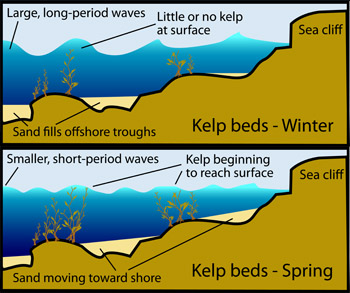
Welcome back! Today we will be talking about the life cycle of kelp and its reproduction. Kelp growth is dependent on temperature, light, photoperiod, presence of rocky coast, water current, salinity, and nutrition availability. The most growth for kelp happens during the spring due to increased light levels and temperature. In North America, the optimum temperature is 10-15°C. The image below shows the distribution of kelp which is near the coasts. This is caused by upwelling which is when cooler waters from the bottom of the ocean are brought up. Due to global warming occurring, kelp forest are being affected because the kelp cannot survive in too warm waters.
https://www.researchgate.net/publication/262798428_New_England_Seaweed_Culture_Handbook_Nursery_Systems/download

https://slideplayer.com/slide/6219664/

http://seasonsinthesea.com/mar/kelp.shtml
https://www.researchgate.net/publication/262798428_New_England_Seaweed_Culture_Handbook_Nursery_Systems/download
Fact of the day: Kelp can grow up to 18 inches in one day!
Kelp has both sexual and asexual reproduction. For asexual reproduction, fragments of kelp are used to reproduce. For sexual reproduction, kelp is formed through the fertilization of an egg. For sexual reproduction, large fronds called sporophytes blades have mature sorus tissue which releases zoospores or meiospores which settle in 48 hours. These settle spores shed their flagella which was used for movement and initiate microscopic stage which starts the gametophyte stage. The gametophyte stage is when spores develop into male and female gametophytes. The cells differentiate into male antheridia or female oogonium. The male antheridia forms sperms and the female oogonium is used to produce eggs. The sperm that was produced is used to fertilize an egg to form a zygote. Once the egg is fertilized, the diploid zygote divides and develops into the small juvenile sporophyte which is produced basally as blade expands and will develop into the holdfast which is the anchor of the kelp, eventually into mature sporophyte which is then used to start reproduction again.
Kelp is phototrophic organisms. Because they are a phototrophic organism, they use photosynthesis to convert light energy into carbohydrates for food. Kelp acquires nitrogen from the water during winter and uses it for producing food. Kelp is used for nitrogen fixation. During the winter, due to limited light levels nitrogen levels are high so kelp is used to fixate the nitrogen. Stay tuned next week for a special surprise!
https://www.researchgate.net/publication/262798428_New_England_Seaweed_Culture_Handbook_Nursery_Systems/download

